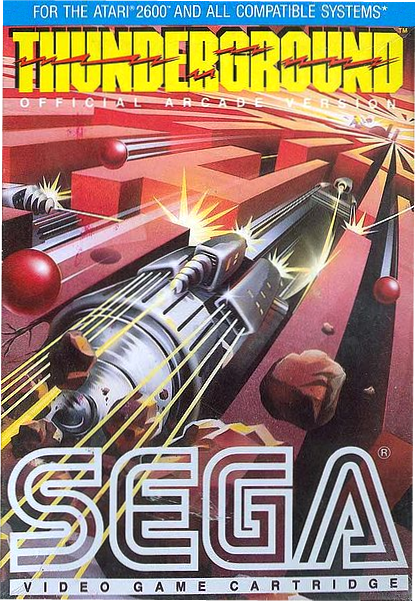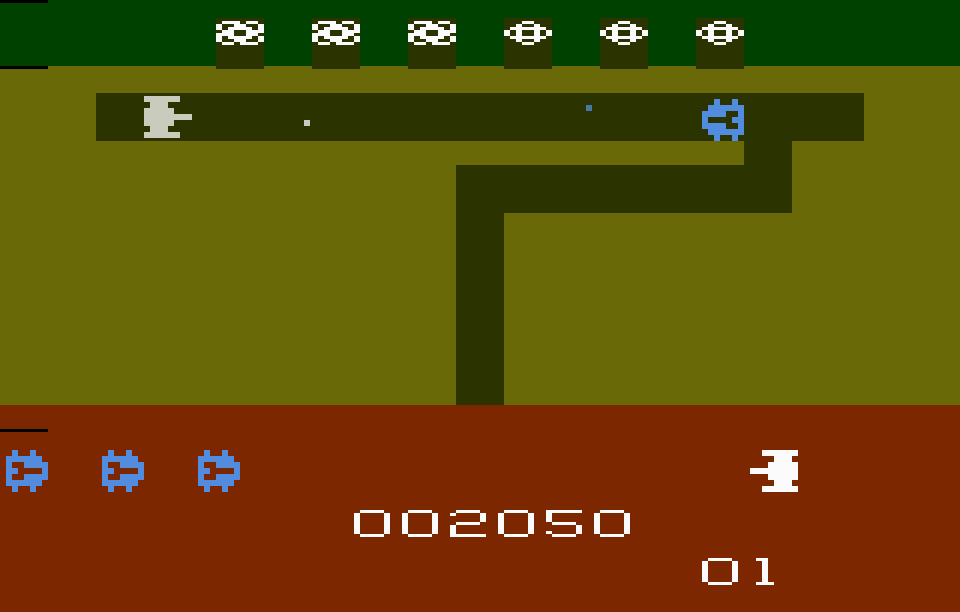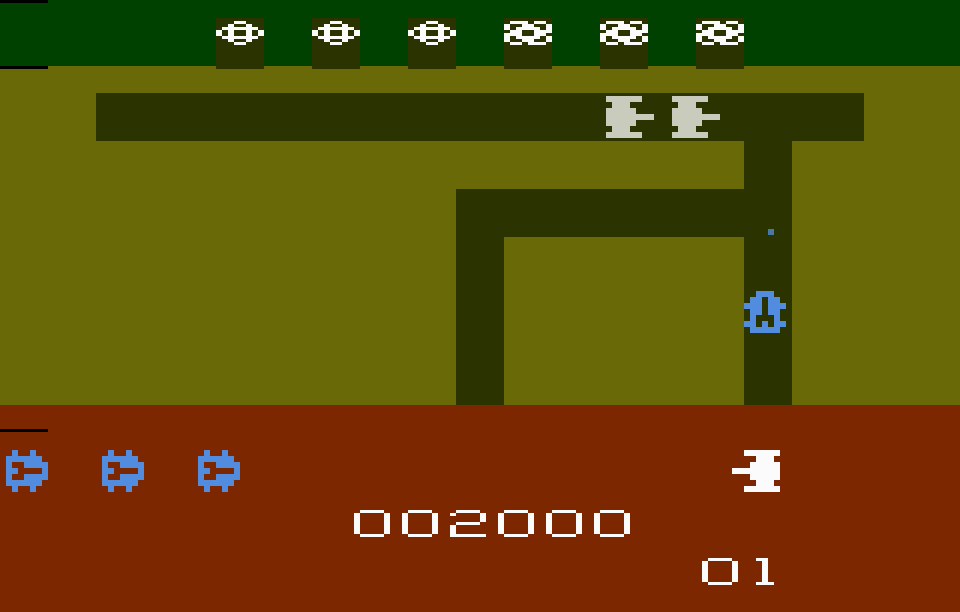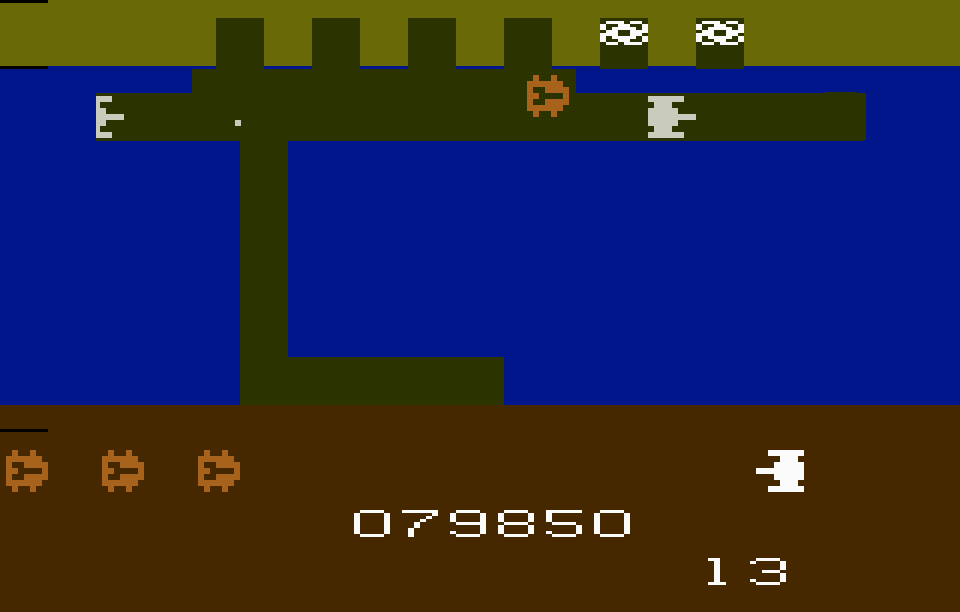Games That You Should Try Again
THUNDERGROUND
Overt conversions and vaguely related variants alike, all nine of Sega's Atari 2600 games were arcade-based. Most sprang from the company's own coin-ops; the rest were licensed from Bally / Midway. Three of the former are better than their originals. Two retain their parents' names -- Star Trek and Buck Rogers: Planet of Zoom -- and one doesn't.
Thunderground upgrades the second stage of Sega / Gremlin's Borderline, a 1981 arcade game that plays like a rough draft. The first stage imposes vertical scrolling, whereas the other three, like the superior home game, feature fixed playfields. They're each completed when the player pulverizes one or more of the curiously diminutive energy reactors from his fortified jeep, and they all provide choppy movement and distractingly dismal color combinations. Sounds like a scream, doesn't it?
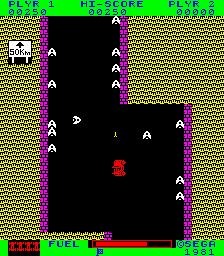
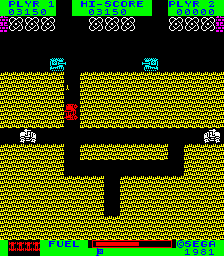
It was reissued later in the year (with slightly altered graphics) as Star Raker, even if a shovel would have been more appropriate. Implementation aside, it contains some great ideas -- the grounds for my uncharacteristic scorn above, as they set up a let-down -- and the best are preserved in the four-kilobyte Thunderground, which was designed and programmed by Jeff Lorenz (2600 Spy Hunter, Star Trek and Tac / Scan) and made available in '83.
It's one of three 2600-exclusive Sega games, the others being the two Scan games (Sub Scan is a rip-off of Taito's Sub Hunter coin-op, which Gremlin released in America as Depthcharge, also in '77). As one expects on this console, Thunderground comprises smooth movement, faultless collision detection and fluid controls. It's infinitely better than its source, even generating several of its own, extremely uncommon tactical scenarios, and provoking unique strategies.
The player operates a vehicle that the instructions call the Core Capsule. I call it the Shoveling Sports Car. (Well, look at it.) White, non-tunneling Sentry Tanks, blue Digger Tanks and an enormous amount of dirt protect the six spinning reactors from vulnerability to the player's projectiles.
According to the manual, the nearly screen-sized subterranean section is actually a massive force field. Whichever you prefer, your car creates its own maze, Mr. Do!-style, as it burrows through the stuff in any of four directions. The ground here is very thunderous indeed! (I had to.)
Your primary targets are officially known as Vector Nuclear Bases, whatever the hell that's supposed to mean. When I'm playing, they're reactors, damn it. Bases don't spin. Their occupants wouldn't want to compromise their crusade by getting dizzy. Besides, bases of any type tend to be bigger than sports cars, and these aren't. There's no room inside the car for anything but the driver and one thin companion, typically enough; but thanks to the wonders of science, it's capable of discharging a never-ending number of destructive energy dots.
This is the variety of dot that Pac-Man carries with him in case he's ever held prisoner by the Monsters (or Ms. Pac-Man) and facing suicide in lieu of running his big mouth under duress. I'm not sure what he would be asked. "Where do you put it all," maybe.
What's really cool about this game is the car's distinctive firing system, preserved from Borderline: The dots are launched along two alternating courses. While both zip straight ahead, one issues from the driver's side, the other from what would be the passenger's if anyone were crazy enough to get in with you. Atari's Submarine Commander is the only other 2600 game I can think of whose player can miss a target with one shot and, without changing positions, hit it with the next. The headlights on this car certainly don't consist of standard bulbs.
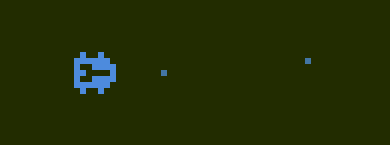
Four rounds make up each of the game's twelve levels. Taking out all six reactors beats the current round. Only two of your deadly dots can exist at once, but this is hardly noticeable, as they travel extraordinarily fast. Your firing range extends to the screen borders, unless your shots are stopped by tanks (even as they blow up) or force-field dirt. Enemy shells are likewise thwarted.
Your dual firepower might seem to make tank-trashing disagreeably easy. You can surely confront the thing, aligning your car with its treads instead of gambling with its gun, and fire twice to ensure that at least one of your noxious dots does the job. This succeeds on occasion, but getting even roughly in front of a tank is needlessly chancy when the maximum number (two) prowl the same half of the screen, as there's a lot of dodging involved; and it's outright foolish when they share a latitude, like they do as a round begins. Whenever tanks face one another, you've got two different shell paths to skirt, as they each fire from slightly to the right of center, assuming a forward view from within. Their cannons presumably haven't been cleaned in a while.
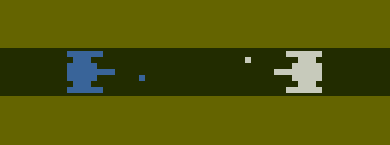
Either tank reverses direction upon contact with the other, even if you've blasted the latter and its flashing flare-up hasn't quite faded. Your car can drive right through this motionless, tank-shaped explosion, so you've got an advantage. Only collision with an intact tank or its shell will wreck your mighty Shoveling Sports Car, provided that you don't run out of time (more on this later). To equalize things a bit, the tanks are impervious to one another's shots.
Instantly driving northward and taking out the reactors as quickly as possible might appear to be the most sensible round-beating method, but it will prove detrimental if your motives include scoring high. First, tunnel around until you find the hidden bonus object, remembering that white tanks will follow your improvised labyrinth, whereas blue ones will form their own passages, thank you very much. Either will fire the moment you're spotted, or even detected through dirt (which wouldn't happen if you'd chosen a car with a quieter engine). Happily, only two enemy shots can be on screen at once.
Mining each round's dirt shield until you get a present makes all the difference between a low score and a high one; the extra points really add up. The first item, which looks like a gasoline pump, always appears in the same place -- about two car lengths southward of the pre-cleared strip, and one to the east of the easternmost reactor -- but the rest are situated randomly. A straightforward if objective-based shoot-out is thus expanded to integrate a treasure hunt. This is, of course, awesome.
Among the other presents are shovels (which you clearly don't need), house keys (in case you make it out of here alive) and a flag (so you can decorate your car and annoy whoever's driving the tanks). I guess it's possible that you're actually stealing enemy supplies. Either way, you deserve some sort of reward for screwing up your front bumper like this. There's only one object in each round, so you can subsequently focus on reactor eradication. Take into account that your alternating shots let you fire around a tank that you've wiped out in front of a reactor.
Notice the tank beneath the playfield. It's slowly rolling toward my back-up cars. When it nears them, I'll hear a warning signal, which will make me think that I'm picking up a lot of presents before I realize that I'm running out of time.
When the tank reaches the front vehicle, my active one will blow up. This doesn't make sense, but at least a new turn will begin, as if I've simply lost a "life" in some other way. It would be a drag if the timer tank just moved on to the next dormant car, as it wouldn't take long to get there.
I've never noticed the clock affecting my game-play; it's more than fair. It serves mainly to half-subliminally galvanize you, as it affords your mission a sense of import, and makes you feel like a bad-ass when you've nailed the final reactor and your time-remaining points are being computed. Notwithstanding these, it's always worth finding the present before you do anything else. There's no comparison between the two kinds of score boost, because each of the reactors is worth from 100 to 2,000 points more post-present, depending on the round.
Returning to the gun-fight aspect, one of the most fun ploys to employ is to wait in a tunnel as a tank approaches in a perpendicular one, and fire just as it lines up with you. Keep your distance; if you don't hit the tank before it can shoot, you'll naturally want to get out of the way after you let your dots fly. Destroying both tanks around the same time prompts staggered reinforcements.
If you lure a blue tank to the far north near either side border, then budge just southward enough to stay out of its line of fire, it will dig through the reactors' thin row of protective dirt for you. Simply stay ahead of the tank and turn away as it exposes the last target.
This is especially useful in every fourth round, in which that's the only dirt on the screen. The benefit over removing it yourself is that you're taking up the tank driver's attention while staying safe from his trigger finger. All the same, I recommend doing this only when the other tank has been eliminated and its standby hasn't arrived yet.
An extra car joins your reserves when a new level begins. Up to three can be displayed; when they're all gone, a car-shaped zero appears, indicating your last chance. The round number is found in the bottom-right corner. You're tackling white tanks in the first round, one of each in the second, and blue in the others. Whenever the cycle restarts, the dirt is colored differently and your opponents' shells fly faster (to a point, albeit an extreme one). They're apparently always improving their equipment. In fact, from the second level onward, only one reactor appears at a time. That's some serious cloaking technology.
Your rivals aren't smart about everything, though. It's not a very good shield that can't even stop a sports car, shoveling kind or not. It does block your shots, of course, requiring a great deal of clearing. Also, the sixth reactor is unwisely made conspicuous as the last: It rapidly flashes through several colors.
You can initially tail a tank until it hits a boundary and turns around, but tanks of both colors are increasingly liable to reverse direction when you're behind them. This properly begins in Round 17. They never speed up, but the blue ones are gradually more likely to dig toward you; they start to get noticeably aggressive in 11.
Exploit this, enticing them into the shield area to make ol' Reactor Row relatively safe. The white tanks are just as apt to pursue you southward when they can, so you can bait them away from the northern section as well.
Throughout every fourth level, the dirt you remove isn't replaced as new rounds commence. The warren you fashion remains until you reach Round 17, 29, etc., but there's always a new present to be found. The usual invisible dirt doesn't appear (well, not appear) in 16, 28 and so on, but there's hardly any left by that point anyway.
Bear in mind that you can fire through a very thin, vertical layer of dirt. Your dots give out just beyond it, but they're no less lethal. The tanks can't do this (HA), and the white ones, true to form, can't drive through it. Also distinctly from the tanks, you can stop moving whenever you like.
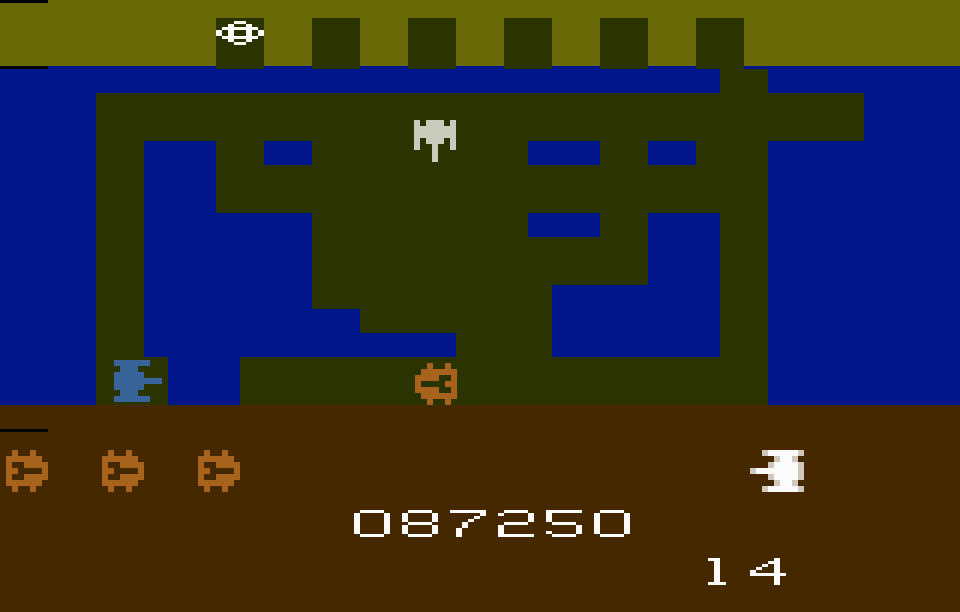
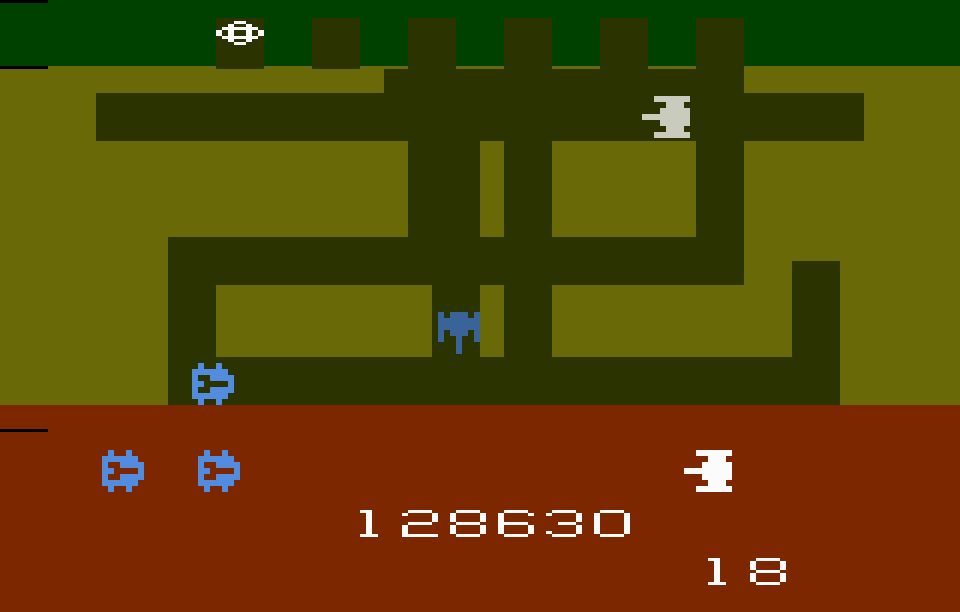
When Level 9 begins with Round 33, exploding tanks are no longer harmless. Stay alert to this, as it takes a while to kick the habit of plowing right through them. Frankly, you probably won't have to worry about it. You're unlikely to be as good as I am. If you actually manage to reach the first round (45) of Level 12, your car will speed up. I'm not sure why you're waiting so long to revamp the engine. The minor boost will help with shell evasion, but you clearly won't need the concession by that point. If you clear 12, the sequence will start over, at least in terms of dirt color. The reactors will still materialize piecemeal, and tank wreckage will remain ruinous until it fully dissipates.
As your foes track you more tenaciously and the need grows to draw them away from wherever you want to be, the fleeting maze-shoot-'em-up situations get more diverse. As usual in regard to the best old games, then, just a few elements coalesce to render unexpected complexity.
As a matter of fact, there's ever more to notice that can help one play more shrewdly. When a stage contains both types of tank, for instance, the blue one always enters from the west, the white from the east. Also, the pause before an obliterated tank gets replaced is steadily condensed, so it's increasingly sensible to stay away from the northern corners when there's just one adversary on the screen -- or, in fact, to let both tanks survive, removing the concern altogether. You can't turn on a dime, but the implied movement grid isn't as bulky as in, say, 2600 Dig Dug.
As you can see, there's a lot more to Thunderground than you're likely to notice at first. Even so, the intricacies don't dilute the visceral impact of engaging in a clear-cut shoot-out; nor do they mask the game's cunning personality. (Well, of course games have personalities.) Lorenz plucked a single lump from a lackluster coin-op and sculpted an exciting, brilliantly balanced console conflict. Try it out and stick with it for a while. I bet that you'll be reaching for "Reset" quite a few times, convinced that you can reach a higher round, and never once wondering where you're putting all of that dirt.
